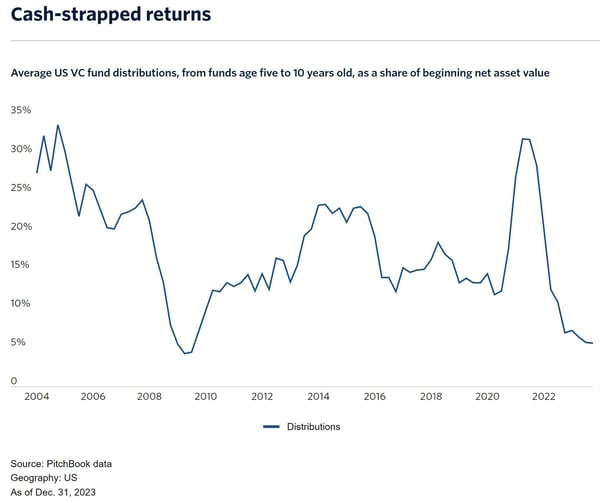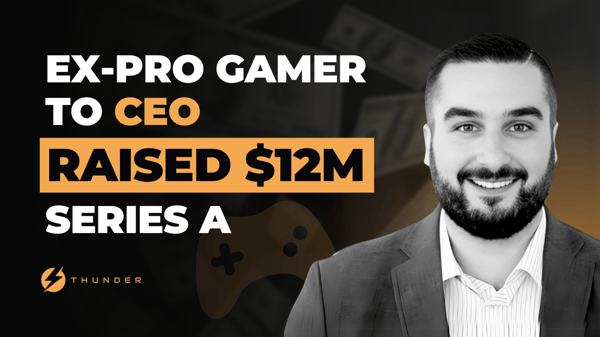What's Below in Issue #67:
📰 - A look into convincing journalists to run your story
📊 - Data behind the VC difficulty around DPI
🎙️- Podcast w/ Nick Cuomo founder of Allstar.gg, raised $12M Series A for gaming startup
💵- Premium startup resources
🆓- Free startup resources
-------------------------------------------------------------------------------------------------------------------------------------------------------------
Non-Dilutive Financing Sounds Way Better, Right?
The cost of equity capital is getting expensive; debt or working capital might be a better option if you're already generating revenue, and it's non-dilutive.
We've made it easier than ever to get matched with private capital providers and receive offers in minutes, not weeks or months.
*We don't charge any fees to source you debt*
Explore Non-dilutive Financing
------------------------------------------------------------------------------------------------------------------------------------------------------------
How to Convince Journalists to Run Your Story
Attention is an expensive commodity that every startup needs. During this past year’s Superbowl, companies spent up to $8M to have 30 seconds of fame (not including production costs). While this may be a far-off aspiration for founders, being advertised in popular media outlets is completely within their means - and I’m not talking about ads.
Having yourself or your company featured in large news sources such as the New York Times, The Wall Street Journal, TechCrunch, and Entrepreneur boosts the visibility of your product and helps validate your relevance to potential customers. The bad news is that having your story picked up by a media outlet is extremely competitive. The good news is that as a founder raising VC money, you have been practicing the necessary skills to sell your story.
Journalists are inundated with tens of potential stories every day. Most are not relevant to their area of expertise, and they can only choose a few to run. Your goal is to break through the noise and prove that your story is relevant and better than the rest.
Preparing Your Story
Before you reach out to any journalist, you need to have a clear and compelling story to tell. It can be about your product, your fundraise, or just an insight or opinion you have about the market you are in. You should ask yourself:
- Is this story relevant to a large audience?
- Is it relevant to any major current event?
- Would the average reader of the publication you're targeting benefit from reading/watching it?
In truth, most stories are not newsworthy. Just because you landed a contract with a large company does not mean that readers will care. Yet, large partnerships with Apple, Google, or Amazon (for example), can be great news stories since people will want to know why they felt your startup was worth working with. Your story should also have a hook or an angle that makes it interesting and relevant to the journalist and their audience. For example, you could tie your story to a current trend, event, or issue that affects your industry or market. You could also highlight a customer success story, a social impact, or a personal story that shows your passion and motivation. Try your best to associate it to a major current event and add your spin to it to tie it back to your company/story.
Once you have a good story, it is important to prepare facts, quotes, and even a potential write-up for the journalist. The easier you make the job for them, the more likely they will work with you.
This step is just like preparing for VC meetings. You need to know why you are relevant and unique, while also preparing materials that make the investor's job easier when conducting due diligence.
Finding the Journalists
In the same way that only a small group of VCs will be a good match for your startup, only a few journalists will be relevant to your story. The worst strategy is to find the email of every journalist and send a mass email asking them to run your story. No VC will take your pitch if you do this, and neither will journalists. You approach the process in the same way.
Google the name of the news outlets you want to work with along with keywords that describe the type of story you want to run. This will help you identify the key journalists in that space. Remember, the closer the fit to your topic, the better. For example, if you have an AI CRM managing app, a journalist who covers technology as a general category will be much harder to work with than a journalist who covers AI or SaaS.
Create a database with all the relevant people and some notes about previous articles they have written. This will help you personalize the emails later, so the more details you can gather the better. You should also be able to find their personal emails on their profile page of the media outlet. This is much more effective than emailing the general email address of the media outlet and hoping it reaches the journalist.
Tips for Pitching Your Story
After you have your story and your media list, you are ready to pitch your story to the journalists. As we have stressed many times, it follows the same strategy as fundraising from VCs. If you can successfully court an investor, then getting a journalist on board should be quite easy. Here are some tips to make your pitch more effective and increase your chances of getting a response:
- Personalize your pitch: Don’t send the same generic email to every journalist. Tailor your pitch to each journalist and mention why you think they would be interested in your story. Refer to their previous work and show that you have done your homework on them.
- Keep it short and simple: Journalists are busy and have short attention spans. Your pitch should be concise and clear and include the most important and relevant information. Use bullet points, numbers, or quotes to highlight your key points. Avoid jargon, buzzwords, or fluff. Remember, you're just trying to get their attention with the first email, not have them write the whole story.
- Differentiate with your subject line: Your subject line is the first thing that the journalist will see and decide whether to open your email or not. Keep it all lowercase, make it feel personal, and leave enough mystery to get them to click, but don't be too cocky. The alternative is to try and come up with an article title that they could swipe if they were to write your story.
- Follow up politely: Don’t expect to get a response right away. Journalists receive tens of pitches every day and may not have time to reply to all of them. Try to reach them on other channels like X and LinkedIn, comment on their posts, and try to add to value to them so you stand out.
- Be prepared: If you get a positive response from a journalist, be prepared and have more follow-up content ready for them to sink their teeth into. Provide any additional quotes, reference materials, or case studies that they request. Be ready to answer their questions.
Getting featured in popular media outlets can be a great way to boost your startup’s visibility and credibility. However, it requires some preparation, research, and persistence. By following these tips, you can craft a compelling story, find the right journalists, and pitch your story effectively.
Relevant Articles for Pitching to Journalists
- How to Write a Media Pitch (w/ 7 Real Examples from Experts) - 👉 Prowly
- 10 Tips for Founders on Engaging with Reporters - 👉 Harvard Innovation Labs
- Pitches That Placed: How to Pitch Founders to Forbe - 👉 One Pitch
-------------------------------------------------------------------------------------------------------------------------------------------------------------Data Corner

VC Funds are Struggling to Pay Up
It is great to be invested in a top-performing startup, but there is no real reward if you're never given a payout for that investment decision. VCs are having difficulty dispersing cash from investments, pushing LPs away from investing in new funds. This will impact how they invest in new startups. It will be much more focused on having the ability to return capital.
-------------------------------------------------------------------------------------------------------------------------------------------------------------Fundraising Demystified Episode #35 is Live!

In this episode, Nick Cuomo, CEO of AllStar.gg, shares his journey from the esports world as a former pro gamer to founding a gaming technology startup. With a background in graphic design, digital marketing, and SaaS sales, Nick discusses his career path and the evolution of AllStar's mission to empower gamers as creators.
Nick walks us through his fundraising journey, detailing how he attracted investors by optimizing user growth and engagement metrics. He also discusses the importance of building strategic connections and staying adaptable to market shifts, while offering practical advice for maintaining resilience during the fundraising process.
Here's what you're in for:
- 00:00 Intro
- 00:31 Nick's Journey into gaming and entrepreneurship
- 10:50 Fundraising journey and initial challenges
- 21:11 The fundraising process
- 26:25 Adapting to market shifts and raising Series A
- 35:37 Metrics and benchmarks that attracted investors
- 39:47 Advice for founders
ABOUT NICK:
Nick Cuomo is a former professional gamer and viral gaming video creator. With over 15 years of experience in technology, marketing, software, sales, and digital media, Nick's entrepreneurial spirit led him to establish Allstar in 2019. Their mission is to empower gamers to become creators by simplifying the process of sharing gameplay through innovative technology.
Connect with Nick on:
Linkedin: /cuomon
Website: www.nickcuomo.com
-------------------------------------------------------------------------------------------------------------------------------------------------------------
Free Fundraising Resources
🤓 - Free pitch deck reviews - Submit your deck
💸 - Access working capital fast - Explore options for free
😍 - Free list of AI Recommended VCs - Apply for free
👨💻 - Free fundraising coaching session - Schedule 15 minutes with us
📝 - Playbook for Negotiating Term Sheets - Download it Here
💽 - Playbook for Setting Up and Sharing Your Data Room - Download it Here
✉️ - Playbook for Sending Investing Updates - Download it Here
Premium Resources
Your pitch deck built by VCs and designers
🗓️ - Book a one-hour private capital strategy call - Book Now
💫 - Pitch deck design services for founders by VCs - Decko
💼 - Startup Legal Services - Bowery Legal
📚 - Startup Friendly Accounting Services - Chelsea Capital
Download Your List of Targeted Investors:
- Access to VC firms' team tabs to see active partners of the fund & their LinkedIn
-
Navigate a VC's portfolio to see relevant portcos or competitors, quickly find their founders on LinkedIn to connect with them, and request warm introsA downloadable CSV with the investor emails & LinkedIn URLs
- Ability to filter your matches and adjust your profile
-
LiteCRM to track your progress
-
Request intros to VCs directly through the platform
- Get our fundraising guide on how to increase your odds of getting a meeting
- Upgrade to lifetime access (one-time fee of $497) and get a free coaching session
Upgrade Now for $59/month
-------------------------------------------------------------------------------------------------------------------------------------------------------------
Let's stay in touch:
- Written by Jason Kirby - https://www.linkedin.com/in/jasonrkirby
- Subscribe to our weekly newsletter for market and industry news and tips when it comes to raising capital and growing your business - https://join.thunder.vc
- Seeking to raise capital? Get your list of target VCs by creating a free profile here - https://web.thunder.vc
- Looking to raise debt? Explore tailored debt options for free by completing a profile at https://debt.thunder.vc



